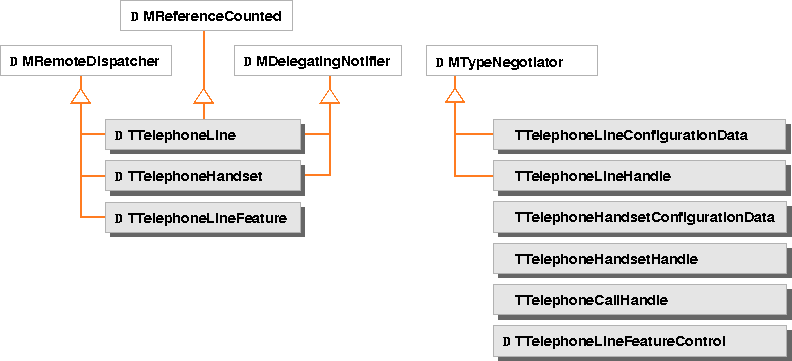The Telephony system supports computer-based telephony by providing a high-level interface to voice-oriented telephone functions. The system insulates application-level code from differences in telephony hardware and provides a flexible framework that can be extended to support new features. It also accommodates unique combinations of telephone sets, local hardware and software platforms, network types, and switch signaling protocols.
NOTE  The Telephony system does not address use of the telephone for serial data communications.
The Telephony system does not address use of the telephone for serial data communications.
In the real world, the most common telephony object is the single-line telephone handset that you connect to a telephone line by plugging it into a wall jack. This connection makes the phone line accessible through the handset. For computer-based telephony, the computer is connected to the line through an internal or external device, such as a modem or telephone interface. The handset no longer connects directly to the line, but to the same device as the computer. In some cases, this allows the computer to query or control the handset.
Read "Telephony concepts" on page 347 for an overview of the Telephony system. "Placing a call," "Answering a call," and "Putting a call on hold" demonstrate how you can use the Telephony classes. If you are interested in providing support for specific telephony hardware, see "Supporting telephony hardware" on page 357.
The four primary telephony objects are lines, handsets, features, and calls. The Telephony system provides two sets of classes: classes that represent shared telephony objects, and handles (surrogates) for accessing them from a program.

TTelephoneLine represents a telephone line and provides a low-level interface to simple telephone network functionality.
TTelephoneLineHandle is a surrogate for a telephone line. You use line handles to access the basic line functions.
TTelephoneLineConfigurationData contains information about the configuration of a specific telephone line, including the endpoint phone number(s) and the features that are currently available on the line.
TTelephoneHandset represents the physical telephone terminal equipment and provides a low-level interface to simple handset functions.
TTelephoneHandsetHandle is a surrogate for the physical telephone terminal equipment.
TTelephoneHandsetConfigurationData contains information about the configuration of a specific telephone handset and specifies the telephone lines to which the handset can be connected.
TTelephoneLineFeature represents advanced telephony features. Concrete classes derived from TTelephoneLineFeature implement specific features, such as conferencing and forwarding calls.
TTelephoneLineFeatureControl represents controllers for advanced telephony features. You use concrete classes derived from TTelephoneLineFeatureControl to access and control specific features.
TTelephoneCallHandle represents the application-level view of a telephone call.
TTelephonyException is a concrete error class derived from TStandardException that defines the errors generated by the Telephony classes.
[Contents]
[Previous]
[Next]
![]() Click the icon to mail questions or corrections about this material to Taligent personnel.
Click the icon to mail questions or corrections about this material to Taligent personnel.
Generated with WebMaker